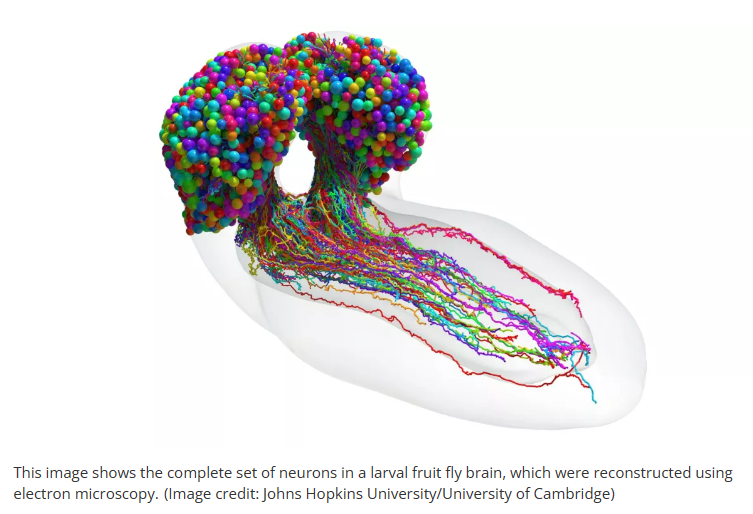Scientists have unveiled the first complete map of an insect's brain.
The comprehensive map, called a connectome, took 12 years of meticulous work to construct, and shows the location of all 3,016 neurons in the brain of a larval fruit fly (Drosophila melanogaster). Between those brain cells are 548,000 points of connection, or synapses, where cells can send each other chemical messages that, in turn, trigger electrical signals that travel through the cells' wiring.
Researchers identified networks through which neurons on one side of the brain send data to the other, the team reported March 9 in the journal Science(opens in new tab). The team also classified 93 distinct types of neurons, which differ in their shape, proposed function and the way they connect to other neurons.
"This study is the first to be able to map the entirety of an insect central brain and thus characterize all synaptic pathways of all the neurons," Nuno Ma?arico da Costa(opens in new tab) and Casey Schneider-Mizell(opens in new tab), members of the Neural Coding group at the Seattle-based Allen Institute for Brain Science who were not involved in the initiative, told Live Science in a joint email.
In 2020, a different research group published a partial connectome of an adult fruit fly(opens in new tab) that contained 25,000 neurons and 20 million synapses. But scientists have complete connectomes for only three other organisms: a nematode, a larval sea squirt and a larval marine worm. Each of those connectomes contains a few hundred neurons and lacks the distinct brain hemispheres seen in insects and mammals, said study co-senior author Joshua Vogelstein(opens in new tab), director and co-founder of the NeuroData lab at Johns Hopkins University.
More than 80 people helped to construct the new connectome, study first author Michael Winding(opens in new tab), a research associate in the University of Cambridge Department of Zoology, told Live Science in an email. To do so, scientists thinly sliced a larval fly brain into 5,000 sections and snapped microscopic images of each slice. They pieced these images together to form a 3D volume. The team then pored over the images, identified individual cells within them and manually traced their wires.
The resulting map surprised scientists in several ways.
For example, scientists tend to think of neurons sending outgoing messages through long wires called axons and receiving messages through shorter, branched wires called dendrites. However, there are exceptions to this rule, and it turns out that axon-to-axon, dendrite-to-dendrite and dendrite-to-axon connections make up about one-third of the synapses in the larval fly brain, Winding said.
The connectome was also surprisingly "shallow," meaning incoming sensory information passes through very few neurons before getting passed to one involved in motor control, which can direct the fly to perform a physical behavior, Vogelstein said. To achieve this level of efficiency, the brain has built-in "shortcuts" between circuits that somewhat resemble those in state-of-the-art AI systems, Winding said.

Copyright © 2024 International Society of Bionic Engineering All Rights Reserved
吉ICP备11002416号-1









